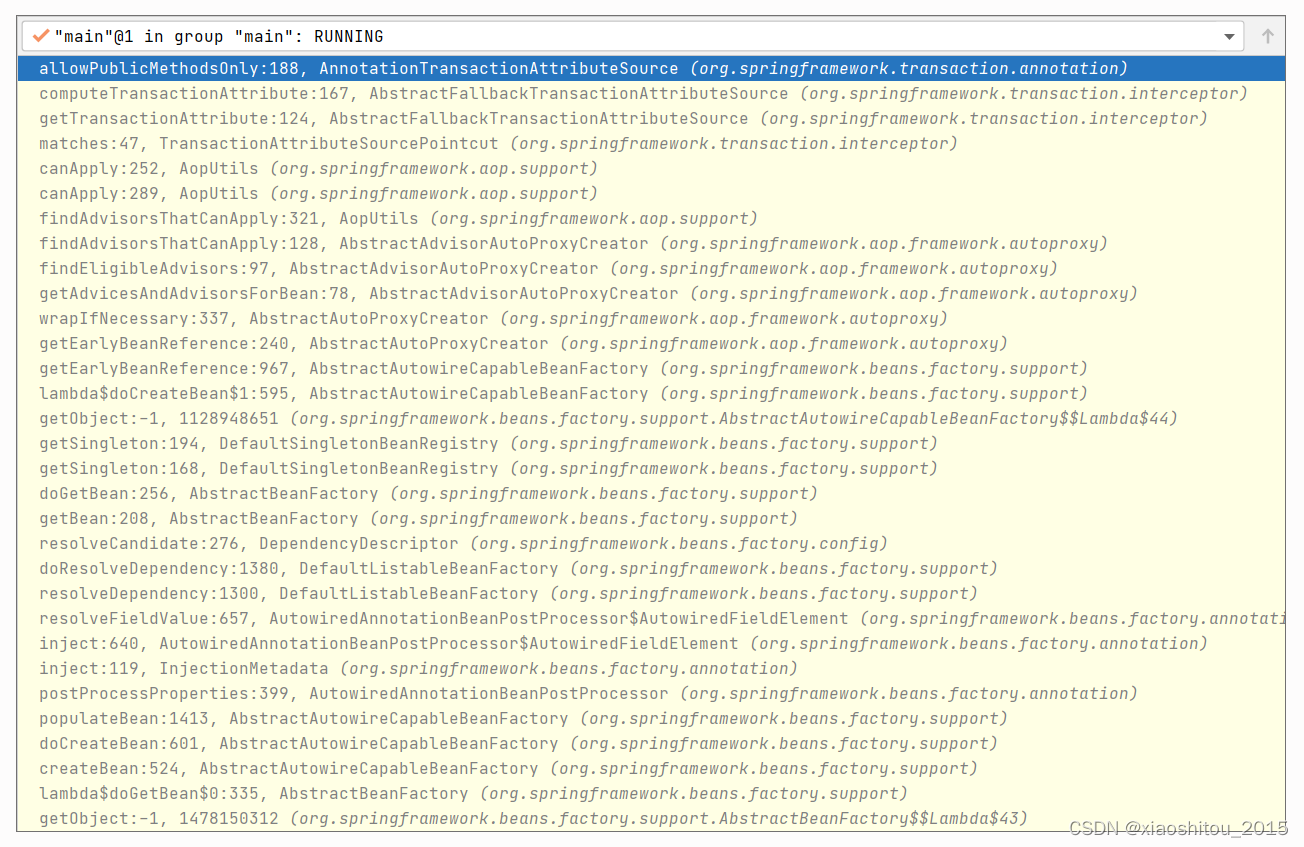通过上一章的学习,我们了解了 Spring Data 操作数据库的一些常见问题。这一章我们聊一聊数据库操作中的一个非常重要的话题——事务管理。
Spring 事务管理包含两种配置方式,第一种是使用 XML 进行模糊匹配,绑定事务管理;第二种是使用注解,这种方式可以对每个需要进行事务处理的方法进行单独配置,你只需要添加上 @Transactional,然后在注解内添加属性配置即可。在我们的错误案例示范中,我们统一使用更为方便的注解式方式。
另外,补充一点,Spring 在初始化时,会通过扫描拦截对事务的方法进行增强。如果目标方法存在事务,Spring 就会创建一个 Bean 对应的代理(Proxy)对象,并进行相关的事务处理操作。
在正式开始讲解事务之前,我们需要搭建一个简单的 Spring 数据库的环境。这里我选择了当下最为流行的 MySQL + Mybatis 作为数据库操作的基本环境。为了正常使用,我们还需要引入一些配置文件和类,简单列举一下。
1.数据库配置文件 jdbc.properties,配置了数据连接信息。
jdbc.driver=com.mysql.cj.jdbc.Driver
jdbc.url=jdbc:mysql://localhost:3306/spring?useUnicode=true&characterEncoding=UTF-8&serverTimezone=UTC&useSSL=false
jdbc.username=root
jdbc.password=pass
2.JDBC 的配置类,从上述 jdbc.properties 加载相关配置项,并创建 JdbcTemplate、DataSource、TransactionManager 相关的 Bean 等。
public class JdbcConfig {@Value("${jdbc.driver}")private String driver;@Value("${jdbc.url}")private String url;@Value("${jdbc.username}")private String username;@Value("${jdbc.password}")private String password;@Bean(name = "jdbcTemplate")public JdbcTemplate createJdbcTemplate(DataSource dataSource) {return new JdbcTemplate(dataSource);}@Bean(name = "dataSource")public DataSource createDataSource() {DriverManagerDataSource ds = new DriverManagerDataSource();ds.setDriverClassName(driver);ds.setUrl(url);ds.setUsername(username);ds.setPassword(password);return ds;}@Bean(name = "transactionManager")public PlatformTransactionManager createTransactionManager(DataSource dataSource) {return new DataSourceTransactionManager(dataSource);}
}3.应用配置类,通过注解的方式,配置了数据源、MyBatis Mapper 的扫描路径以及事务等。
@Configuration
@ComponentScan
@Import({JdbcConfig.class})
@PropertySource("classpath:jdbc.properties")
@MapperScan("com.spring.puzzle.others.transaction.example1")
@EnableTransactionManagement
@EnableAutoConfiguration(exclude={DataSourceAutoConfiguration.class})
@EnableAspectJAutoProxy(proxyTargetClass = true, exposeProxy = true)
public class AppConfig {public static void main(String[] args) throws Exception {ApplicationContext context = new AnnotationConfigApplicationContext(AppConfig.class);}
}完成了上述基础配置和代码后,我们开始进行案例的讲解。
案例 1:unchecked 异常与事务回滚
在系统中,我们需要增加一个学生管理的功能,每一位新生入学后,都会往数据库里存入学生的信息。我们引入了一个学生类 Student 和与之相关的 Mapper。
其中,Student 定义如下:
public class Student implements Serializable {private Integer id;private String realname;public Integer getId() {return id;}public void setId(Integer id) {this.id = id;}public String getRealname() {return realname;}public void setRealname(String realname) {this.realname = realname;}
}
Student 对应的 Mapper 类定义如下:
@Mapper
public interface StudentMapper {@Insert("INSERT INTO `student`(`realname`) VALUES (#{realname})")void saveStudent(Student student);
}
对应数据库表的 Schema 如下:
CREATE TABLE `student` (`id` int(11) NOT NULL AUTO_INCREMENT,`realname` varchar(255) DEFAULT NULL,PRIMARY KEY (`id`)
) ENGINE=InnoDB DEFAULT CHARSET=utf8;业务类 StudentService,其中包括一个保存的方法 saveStudent。执行一下保存,一切正常。
接下来,我们想要测试一下这个事务会不会回滚,于是就写了这样一段逻辑:如果发现用户名是小明,就直接抛出异常,触发事务的回滚操作。
@Service
public class StudentService {@Autowiredprivate StudentMapper studentMapper;@Transactionalpublic void saveStudent(String realname) throws Exception {Student student = new Student();student.setRealname(realname);studentMapper.saveStudent(student);if (student.getRealname().equals("小明")) {throw new Exception("该学生已存在");}}
}
然后使用下面的代码来测试一下,保存一个叫小明的学生,看会不会触发事务的回滚。
public class AppConfig {public static void main(String[] args) throws Exception {ApplicationContext context = new AnnotationConfigApplicationContext(AppConfig.class);StudentService studentService = (StudentService) context.getBean("studentService");studentService.saveStudent("小明");}
}执行结果打印出了这样的信息:
Exception in thread "main" java.lang.Exception: 该学生已存在
at com.spring.puzzle.others.transaction.example1.StudentService.saveStudent(StudentService.java:23)
可以看到,异常确实被抛出来,但是检查数据库,你会发现数据库里插入了一条新的记录。
但是我们的常规思维可能是:在 Spring 里,抛出异常,就会导致事务回滚,而回滚以后,是不应该有数据存入数据库才对啊。而在这个案例中,异常也抛了,回滚却没有如期而至,这是什么原因呢?我们需要研究一下 Spring 的源码,来找找答案。
案例解析
我们通过 debug 沿着 saveStudent 继续往下跟,得到了一个这样的调用栈:

从这个调用栈中我们看到了熟悉的 CglibAopProxy,另外事务本质上也是一种特殊的切面,在创建的过程中,被 CglibAopProxy 代理。事务处理的拦截器是 TransactionInterceptor,它支撑着整个事务功能的架构,我们来分析下这个拦截器是如何实现事务特性的。
首先,TransactionInterceptor 继承类 TransactionAspectSupport,实现了接口 MethodInterceptor。当执行代理类的目标方法时,会触发 invoke()。由于我们的关注重点是在异常处理上,所以直奔主题,跳到异常处理相关的部分。当它 catch 到异常时,会调用 completeTransactionAfterThrowing 方法做进一步处理。
protected Object invokeWithinTransaction(Method method, @Nullable Class<?> targetClass,final InvocationCallback invocation) throws Throwable {//省略非关键代码Object retVal;try {retVal = invocation.proceedWithInvocation();}catch (Throwable ex) {completeTransactionAfterThrowing(txInfo, ex);throw ex;}finally {cleanupTransactionInfo(txInfo);}//省略非关键代码
}在 completeTransactionAfterThrowing 的代码中,有这样一个方法 rollbackOn(),这是事务的回滚的关键判断条件。当这个条件满足时,会触发 rollback 操作,事务回滚。
protected void completeTransactionAfterThrowing(@Nullable TransactionInfo txInfo, Throwable ex) {//省略非关键代码//判断是否需要回滚if (txInfo.transactionAttribute != null && txInfo.transactionAttribute.rollbackOn(ex)) {try {//执行回滚txInfo.getTransactionManager().rollback(txInfo.getTransactionStatus());}catch (TransactionSystemException ex2) {ex2.initApplicationException(ex);throw ex2;}catch (RuntimeException | Error ex2) {throw ex2;}}//省略非关键代码
}rollbackOn() 其实包括了两个层级,具体可参考如下代码:
public boolean rollbackOn(Throwable ex) {// 层级 1:根据"rollbackRules"及当前捕获异常来判断是否需要回滚RollbackRuleAttribute winner = null;int deepest = Integer.MAX_VALUE;if (this.rollbackRules != null) {for (RollbackRuleAttribute rule : this.rollbackRules) {// 当前捕获的异常可能是回滚“异常”的继承体系中的“一员”int depth = rule.getDepth(ex);if (depth >= 0 && depth < deepest) {deepest = depth;winner = rule;}}}// 层级 2:调用父类的 rollbackOn 方法来决策是否需要 rollbackif (winner == null) {return super.rollbackOn(ex);}return !(winner instanceof NoRollbackRuleAttribute);
}1. RuleBasedTransactionAttribute 自身的 rollbackOn()
当我们在 @Transactional 中配置了 rollbackFor,这个方法就会用捕获到的异常和 rollbackFor 中配置的异常做比较。如果捕获到的异常是 rollbackFor 配置的异常或其子类,就会直接 rollback。在我们的案例中,由于在事务的注解中没有加任何规则,所以这段逻辑处理其实找不到规则(即 winner == null),进而走到下一步。
2. RuleBasedTransactionAttribute 父类 DefaultTransactionAttribute 的 rollbackOn()
如果没有在@Transactional 中配置 rollback 属性,或是捕获到的异常和所配置异常的类型不一致,就会继续调用父类的 rollbackOn() 进行处理。
而在父类的 rollbackOn() 中,我们发现了一个重要的线索,只有在异常类型为 RuntimeException 或者 Error 的时候才会返回 true,此时,会触发 completeTransactionAfterThrowing 方法中的 rollback 操作,事务被回滚。
public boolean rollbackOn(Throwable ex) {return (ex instanceof RuntimeException || ex instanceof Error);
}查到这里,真相大白,Spring 处理事务的时候,如果没有在 @Transactional 中配置 rollback 属性,那么只有捕获到 RuntimeException 或者 Error 的时候才会触发回滚操作。而我们案例抛出的异常是 Exception,又没有指定与之匹配的回滚规则,所以我们不能触发回滚。
问题修正
从上述案例解析中,我们了解到,Spring 在处理事务过程中,并不会对 Exception 进行回滚,而会对 RuntimeException 或者 Error 进行回滚。
这么看来,修改方法也可以很简单,只需要把抛出的异常类型改成 RuntimeException 就可以了。于是这部分代码就可以修改如下:
@Service
public class StudentService {@Autowiredprivate StudentMapper studentMapper;@Transactionalpublic void saveStudent(String realname) throws Exception {Student student = new Student();student.setRealname(realname);studentMapper.saveStudent(student);if (student.getRealname().equals("小明")) {throw new RuntimeException("该用户已存在");}}
再执行一下,这时候异常会正常抛出,数据库里不会有新数据产生,表示这时候 Spring 已经对这个异常进行了处理,并将事务回滚。
但是很明显,这种修改方法看起来不够优美,毕竟我们的异常有时候是固定死不能随意修改的。所以结合前面的案例分析,我们还有一个更好的修改方式。
具体而言,我们在解析 RuleBasedTransactionAttribute.rollbackOn的代码时提到过 rollbackFor 属性的处理规则。也就是我们在@Transactional 的 rollbackFor 加入需要支持的异常类型(在这里是 Exception)就可以匹配上我们抛出的异常,进而在异常抛出时进行回滚。
于是我们可以完善下案例中的注解,修改后代码如下:
@Transactional(rollbackFor = Exception.class)再次测试运行,你会发现一切符合预期了。
案例 2:试图给 private 方法添加事务
接着上一个案例,我们已经实现了保存学生信息的功能。接下来,我们来优化一下逻辑,让学生的创建和保存逻辑分离,于是我就对代码做了一些重构,把 Student 的实例创建和保存逻辑拆到两个方法中分别进行。然后,把事务的注解 @Transactional 加在了保存数据库的方法上。
@Service
public class StudentService {@Autowiredprivate StudentMapper studentMapper;@Autowiredprivate StudentService studentService;public void saveStudent(String realname) throws Exception {Student student = new Student();student.setRealname(realname);studentService.doSaveStudent(student);}@Transactionalprivate void doSaveStudent(Student student) throws Exception {studentMapper.saveStudent(student);if (student.getRealname().equals("小明")) {throw new RuntimeException("该用户已存在");}}
}执行的时候,继续传入参数“小明”,看看执行结果是什么样子?
异常正常抛出,事务却没有回滚。明明是在方法上加上了事务的注解啊,为什么没有生效呢?我们还是从 Spring 源码中找答案。
案例解析
通过 debug,我们一步步寻找到了问题的根源,得到了以下调用栈。我们通过 Spring 的源码来解析一下完整的过程。

前一段是 Spring 创建 Bean 的过程。当 Bean 初始化之后,开始尝试代理操作,这个过程是从 AbstractAutoProxyCreator 里的 postProcessAfterInitialization 方法开始处理的:
public Object postProcessAfterInitialization(@Nullable Object bean, String beanName) {if (bean != null) {Object cacheKey = getCacheKey(bean.getClass(), beanName);if (this.earlyProxyReferences.remove(cacheKey) != bean) {return wrapIfNecessary(bean, beanName, cacheKey);}}return bean;
}我们一路往下找,暂且略过那些非关键要素的代码,直到到了 AopUtils 的 canApply 方法。这个方法就是针对切面定义里的条件,确定这个方法是否可以被应用创建成代理。其中有一段 methodMatcher.matches(method, targetClass) 是用来判断这个方法是否符合这样的条件:
public static boolean canApply(Pointcut pc, Class<?> targetClass, boolean hasIntroductions) {//省略非关键代码for (Class<?> clazz : classes) {Method[] methods = ReflectionUtils.getAllDeclaredMethods(clazz);for (Method method : methods) {if (introductionAwareMethodMatcher != null ?introductionAwareMethodMatcher.matches(method, targetClass, hasIntroductions) :methodMatcher.matches(method, targetClass)) {return true;}}}return false;
}从 matches() 调用到了 AbstractFallbackTransactionAttributeSource 的 getTransactionAttribute:
public boolean matches(Method method, Class<?> targetClass) {//省略非关键代码TransactionAttributeSource tas = getTransactionAttributeSource();return (tas == null || tas.getTransactionAttribute(method, targetClass) != null);
}其中,getTransactionAttribute 这个方法是用来获取注解中的事务属性,根据属性确定事务采用什么样的策略。
public TransactionAttribute getTransactionAttribute(Method method, @Nullable Class<?> targetClass) {//省略非关键代码TransactionAttribute txAttr = computeTransactionAttribute(method, targetClass);//省略非关键代码}
}接着调用到 computeTransactionAttribute 这个方法,其主要功能是根据方法和类的类型确定是否返回事务属性,执行代码如下:
protected TransactionAttribute computeTransactionAttribute(Method method, @Nullable Class<?> targetClass) {//省略非关键代码if (allowPublicMethodsOnly() && !Modifier.isPublic(method.getModifiers())) {return null;}//省略非关键代码
}这里有这样一个判断 allowPublicMethodsOnly() && !Modifier.isPublic(method.getModifiers()) ,当这个判断结果为 true 的时候返回 null,也就意味着这个方法不会被代理,从而导致事务的注解不会生效。那此处的判断值到底是不是 true 呢?我们可以分别看一下。
条件 1:allowPublicMethodsOnly()
allowPublicMethodsOnly 返回了 AnnotationTransactionAttributeSource 的 publicMethodsOnly 属性。
protected boolean allowPublicMethodsOnly() {return this.publicMethodsOnly;
}而这个 publicMethodsOnly 属性是通过 AnnotationTransactionAttributeSource 的构造方法初始化的,默认为 true。
public AnnotationTransactionAttributeSource() {this(true);
}条件 2:Modifier.isPublic()
这个方法根据传入的 method.getModifiers() 获取方法的修饰符。该修饰符是 java.lang.reflect.Modifier 的静态属性,对应的几类修饰符分别是:PUBLIC: 1,PRIVATE: 2,PROTECTED: 4。这里面做了一个位运算,只有当传入的方法修饰符是 public 类型的时候,才返回 true。
public static boolean isPublic(int mod) {return (mod & PUBLIC) != 0;
}综合上述两个条件,你会发现,只有当注解为事务的方法被声明为 public 的时候,才会被 Spring 处理。
问题修正
了解了问题的根源以后,解决它就变得很简单了,我们只需要把它的修饰符从 private 改成 public 就可以了。
不过需要额外补充的是,我们调用这个加了事务注解的方法,必须是调用被 Spring AOP 代理过的方法,也就是不能通过类的内部调用或者通过 this 的方式调用。所以我们的案例的 StudentService,它含有一个自动装配(Autowired)了自身(StudentService)的实例来完成代理方法的调用。这个问题我们在之前 Spring AOP 的代码解析中重点强调过,此处就不再详述了。
@Service
public class StudentService {@Autowiredprivate StudentMapper studentMapper;@Autowiredprivate StudentService studentService;public void saveStudent(String realname) throws Exception {Student student = new Student();student.setRealname(realname);studentService.doSaveStudent(student);}@Transactionalpublic void doSaveStudent(Student student) throws Exception {studentMapper.saveStudent(student);if (student.getRealname().equals("小明")) {throw new RuntimeException("该学生已存在");}}
}重新运行一下,异常正常抛出,数据库也没有新数据产生,事务生效了,问题解决。
Exception in thread "main" java.lang.RuntimeException:该学生已存在
at com.spring.puzzle.others.transaction.example2.StudentService.doSaveStudent(StudentService.java:27)
重点回顾
通过以上两个案例,相信你对 Spring 的声明式事务机制已经有了进一步的了解,最后总结下重点:
- Spring 支持声明式事务机制,它通过在方法上加上 @Transactional,表明该方法需要事务支持。于是,在加载的时候,根据 @Transactional 中的属性,决定对该事务采取什么样的策略;
- @Transactional 对 private 方法不生效,所以我们应该把需要支持事务的方法声明为 public 类型;
- Spring 处理事务的时候,默认只对 RuntimeException 和 Error 回滚,不会对 Exception 回滚,如果有特殊需要,需要额外声明,例如指明 Transactional 的属性 rollbackFor 为 Exception.class















)

和load()的用法)

